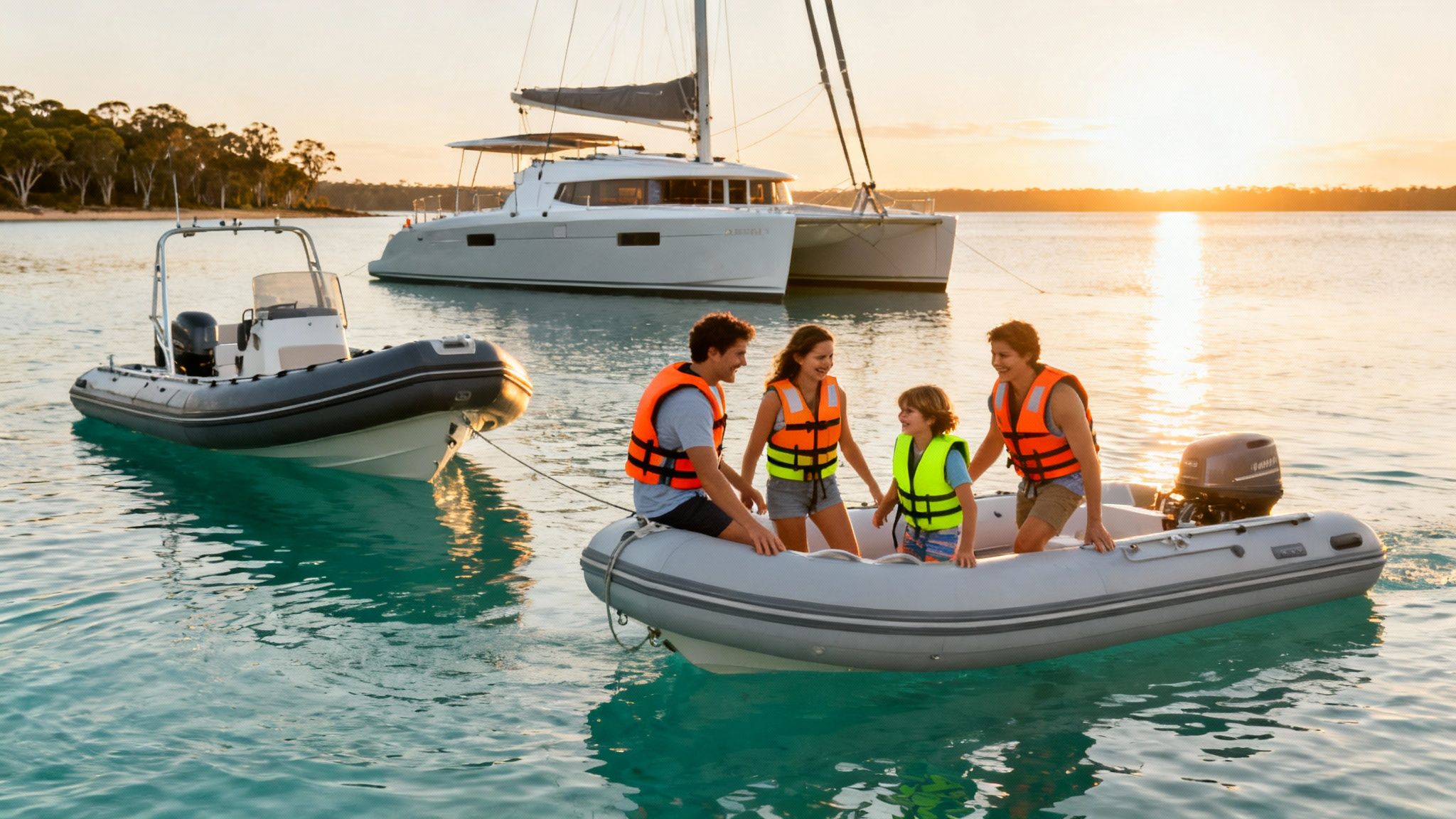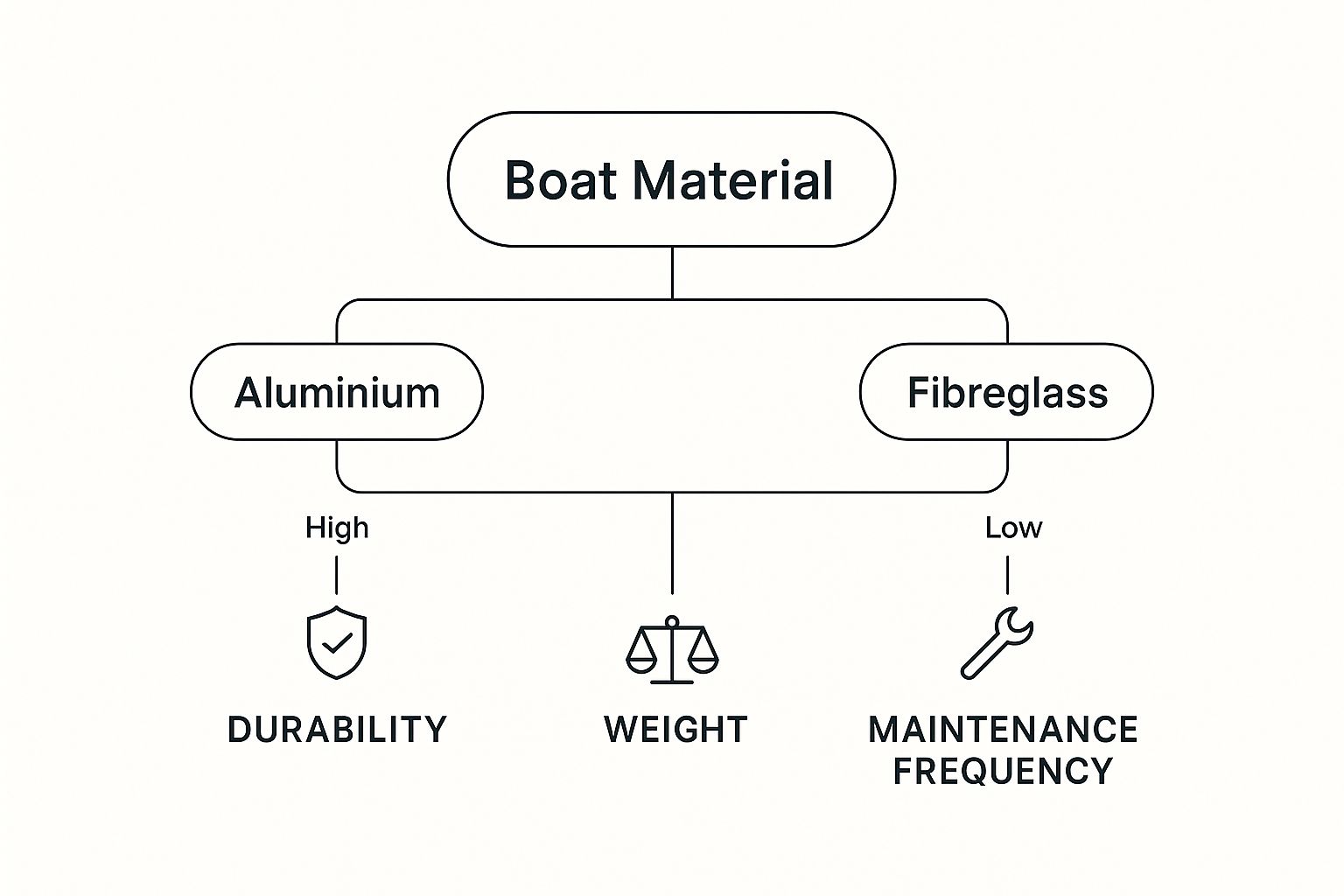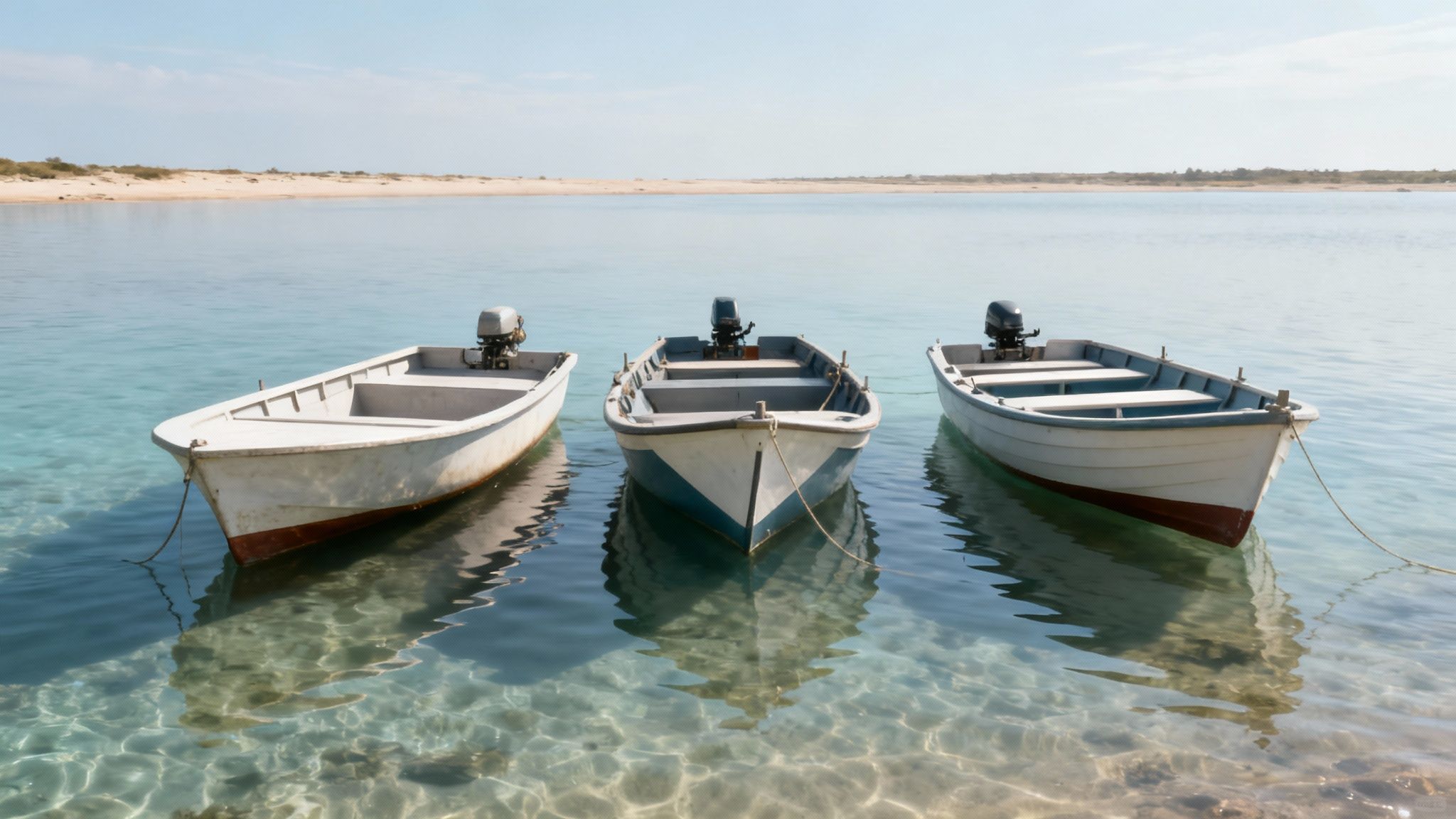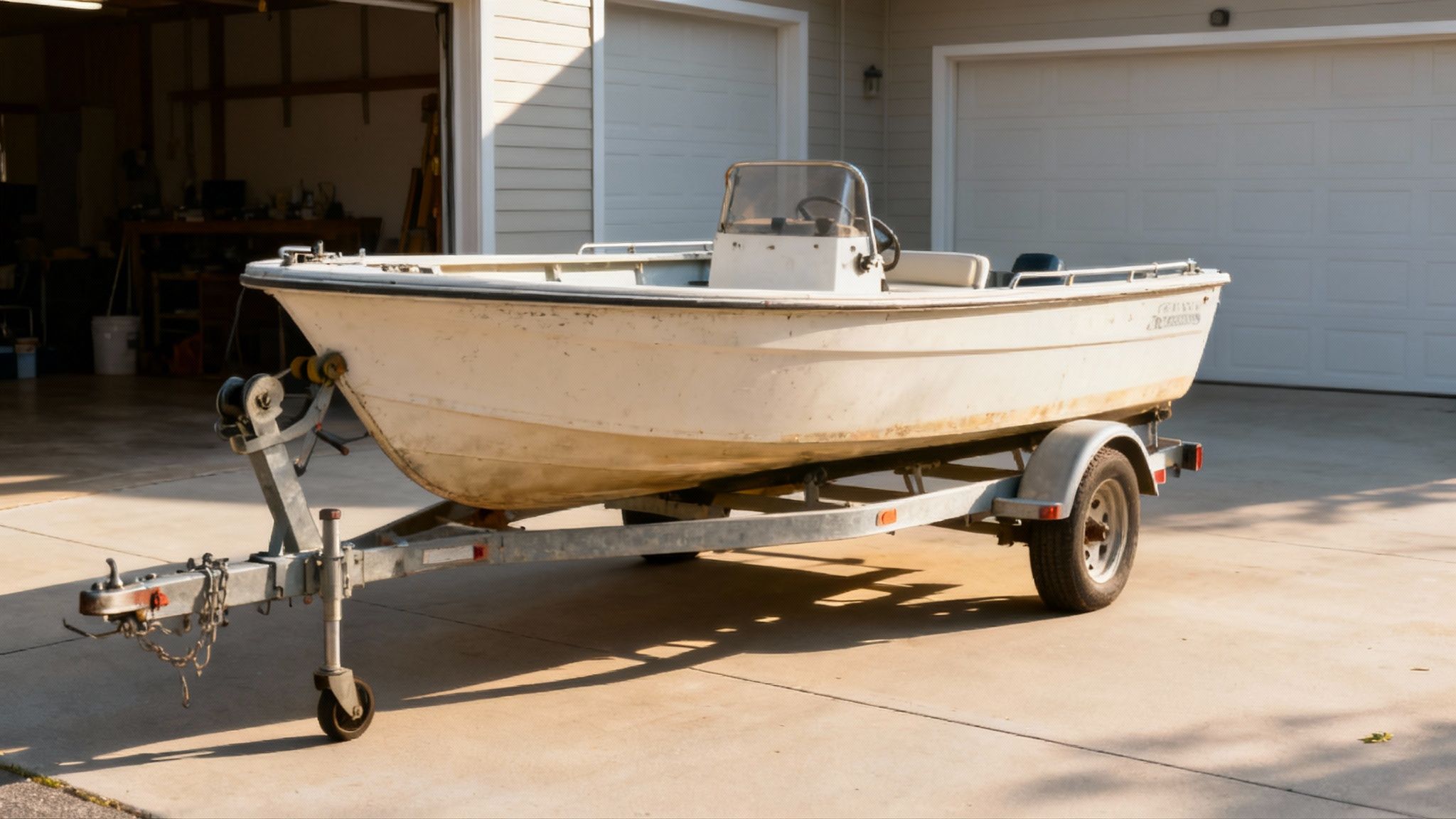
For countless Aussies, the dream of heading out on the water with a fishing rod in hand begins with a small boat. These vessels are the perfect gateway into recreational angling, offering freedom and adventure without the hefty price tag or complexity of larger craft. They're your ticket to exploring serene estuaries, quiet rivers, and sun-drenched coastal bays.
Welcome to your no-nonsense guide to the exciting world of small fishing boats in Australia. If you're keen to get out on the water, you've come to the right place. These boats are incredibly popular for good reason—they hit that sweet spot between capability, affordability, and sheer ease of use.
We’ve structured this guide to build your knowledge from the ground up, turning what can feel like an overwhelming choice into a confident decision.
First, let's define what a 'small' boat really means in practical terms. Forget the technical jargon for a moment. We're talking about a vessel you can easily tow with the family car, launch on your own, and store in the garage or driveway without needing a dedicated marina berth. It's this accessibility that makes them the backbone of recreational fishing right across the country.
In Australia, small fishing boats aren't just a niche; they're the main event. A staggering 85% of all registered boats are under 6 metres in length—a size that’s perfect for trailering and exploring local waterways.
Within that category, about 62% are tough-as-nails aluminium models, affectionately known as "tinnies," which are favoured for their resilience in our diverse and often harsh environments. You can dig into more Australian boating statistics to get a feel for the landscape.
Think of this guide as your roadmap. It’s designed to help you find a boat that lines up perfectly with your fishing ambitions. We'll kick things off with the most fundamental choice you'll face: the material your boat is made from. Get this right, and you're well on your way to owning a vessel that feels like it was built just for you.
A great small fishing boat does more than just float—it becomes your reliable partner on the water. It's the platform for memorable trips with mates, the tool that gets you to those secluded spots, and the key to unlocking countless hours of pure enjoyment.
Our journey is designed to be progressive, making sure you nail one concept before we move on to the next. You'll get a clear understanding of the core elements that make a great fishing boat. Here’s a sneak peek of what's coming up:
By the end, you'll have the confidence to walk into a dealership or check out a second-hand listing and know exactly what you're looking for.
Deciding what your boat is made of is probably the first big decision you'll make, and it’s a crucial one. This choice ripples through everything—durability, how it feels on the water, and how much weekend time you’ll spend on upkeep. For most small fishing boats, it comes down to a classic Aussie showdown: the tough, no-nonsense aluminium 'tinnie' versus the smooth-riding fibreglass boat.
Think of an aluminium hull as the trusty ute of the waterways. It’s built to be knocked around. It’s forgiving, making it perfect for nosing into rocky shorelines or navigating skinny creeks where you might kiss the bottom. Being lightweight, they're a breeze to launch, retrieve, and tow behind a normal family car.
On the other hand, a fibreglass boat is generally heavier and feels more planted in the water. That extra weight helps it slice through chop instead of bouncing over it, giving you and your passengers a much smoother and quieter ride.
This infographic neatly lays out the pros and cons of each material, comparing things like toughness, weight, and maintenance.

As you can see, there's a clear trade-off. Aluminium gives you rugged durability and a lighter load, while fibreglass delivers a more comfortable ride that demands a bit more TLC.
There’s a reason tinnies are an icon of the Australian fishing scene—they just make sense. Their biggest selling point is durability combined with low weight. A clumsy nudge against a boat ramp or an unexpected run-in with a submerged branch will likely leave you with a dent or a scratch, not a trip-ending crack that needs immediate professional help.
This resilience makes them a fantastic choice for anglers who are hard on their gear or frequently explore rough-and-tumble spots. For decades, small aluminium boats under five metres have been the go-to for Aussie fishos and families, loved for being both affordable and tough. For so many of us, our boating journey started in a simple tinny.
Their lighter weight also means real savings in your pocket. You’ll use less fuel, and you won’t need a massive 4WD to get your boat to the water. It all adds up to a very cost-effective way to get out fishing over the long run.
For many, the simple, no-fuss nature of an aluminium boat is its greatest appeal. It's a tool designed to be used, not just admired. The focus is purely on getting you to the fish with minimal hassle.
While aluminium is the undisputed champ of rugged utility, fibreglass boats easily win on ride quality and good looks. The moulding process allows for more complex, hydrodynamic hull shapes, which is exactly why they’re known for slicing cleanly through waves.
This translates to a much more comfortable and drier day on the water, especially when you’re crossing an open bay with a bit of afternoon chop. The extra heft of a fibreglass hull also adds to its stability, both at speed and when you're anchored up. That’s a huge bonus when you’ve got a couple of mates casting lines at the same time.
On top of that, fibreglass boats often feel more ‘finished’ with more integrated features. Things like moulded seats, built-in tackle boxes, and live bait tanks are often seamlessly part of the design, giving the boat a polished, professional look.
While aluminium and fibreglass dominate the market, it’s worth giving a nod to the rise of high-tech inflatable boats. We’re not talking about pool toys here. Modern inflatables are built from incredibly tough, multi-layered fabrics that deliver surprising durability and performance. You can read more about the benefits of advanced PVC and Hypalon materials to see just how far this technology has come.
Their key advantage is portability. An inflatable boat can be deflated, rolled up, and chucked in the boot of a car or a cupboard at home. This opens up boating to anyone who doesn’t have the space for a boat and trailer. They’re also exceptionally stable, thanks to their large air-filled tubes, making them a safe and practical platform for fishing. For anyone who puts convenience and storage first, a quality inflatable is a fantastic alternative to consider.

After you’ve settled on a material, the next piece of the puzzle is the boat's hull—its underwater shape. The hull is arguably the most important factor determining how your boat handles, how stable it feels, and how comfortable your ride will be. It’s the difference between gliding smoothly across a choppy bay and getting bounced around like you’re in a washing machine.
Think of it like choosing tyres for a car. A 4WD needs chunky, aggressive tyres to grip rough terrain, while a city car uses smooth tyres for a quiet ride on pavement. In the same way, different hull designs are engineered for specific water conditions, and picking the right one is essential.
Matching the hull to where you do most of your fishing will make every trip safer, more comfortable, and ultimately more successful. Let's break down the main types you'll come across.
Imagine a plank of wood on the water—that’s the basic idea behind a flat-bottom hull. This design offers incredible stability in calm, protected waters. Because its wide, flat surface sits right on top of the water, it has very little draft. This means it can glide into exceptionally shallow spots where other boats simply can't go.
This makes it the perfect choice for anglers who spend their time in freshwater rivers, dams, and tranquil estuaries. Its exceptional steadiness when you're not moving, known as primary stability, gives you a solid, confident platform for casting. However, that same flatness becomes a huge drawback in choppy conditions, as it will slap against every wave for a jarring and very wet ride.
By far the most common design you'll find on small fishing boats is the V-hull. Just like the name suggests, the bottom of the boat forms a 'V' shape. This lets it slice through waves rather than pounding over them, creating a much smoother ride in choppy water and making it a far more versatile option for coastal bays and bigger lakes.
V-hulls come in different degrees of sharpness, from a shallow-V to a deep-V. A modified V-hull is a popular compromise, featuring a sharper V at the front to cut through waves and a flatter section towards the back to provide better stability at rest. This hybrid design gives you a good mix of comfort on the move and steadiness when you're anchored up.
A V-hull is the all-rounder of the boating world. It strikes a balance between cutting through chop and providing a stable platform, making it the go-to choice for anglers who fish in a variety of conditions.
For those who regularly head into open coastal waters or face rough conditions, the deep-V hull is the undisputed champion. Its sharp, pronounced 'V' shape runs all the way from the bow to the stern, allowing it to cut through serious waves with remarkable softness and control. Handling rough seas is what it does best.
But this excellent rough-water performance comes with a trade-off. The deep-V design is less stable at rest, meaning the boat can rock and roll more when it's stationary or moving slowly. For a solo angler trolling offshore for mackerel, it's a worthy compromise. But if you're often fishing with family in calmer waters, this "tippy" feeling might not be what you want.
If stability is your top priority but you still need wave-handling ability, an inflatable boat with a V-hull offers a unique solution. The large air tubes provide rock-solid stability at rest, while the rigid hull cuts through chop. Talk to our team to find out if this hybrid design is the right fit for your fishing style.
Once you’ve nailed down your ideal material and hull design, it’s time to kit out your boat with the features that turn it into a proper fishing weapon. These are the components that separate a basic tinny from a specialised fishing machine, directly impacting how you fish, how comfortable you are, and ultimately, how successful you are on the water.
It all starts with the heart of any small fishing boat: the engine. The right motor doesn’t just get you from A to B; it defines your boat's reliability, running costs, and even how quietly you can sneak up on flighty fish.
Your decision will mostly boil down to a modern four-stroke outboard versus a simpler, old-school two-stroke. Think of a four-stroke as the modern sedan of the engine world—it's quiet, incredibly fuel-efficient, and produces far fewer emissions. They run smoothly and are perfect for trolling at low speeds without choking you with smoke and noise.
A two-stroke, on the other hand, is more like a classic muscle car. It’s lighter, mechanically simpler with fewer moving parts, and gives you a punchy burst of acceleration. But that performance comes at a cost: higher fuel consumption, more noise, and a smokier exhaust, which can be a deal-breaker for a lot of anglers.
Choosing between these two engine types involves a clear trade-off. While the upfront cost of a two-stroke might be tempting, the superior fuel economy of a four-stroke often makes it cheaper to run in the long term, especially with today's fuel prices.
The right engine becomes an invisible partner on your fishing trips. A quiet, efficient motor lets you focus on the fishing, not the mechanics, while a reliable one gives you the confidence to explore further from shore.
As technology marches on, another exciting option is emerging for anglers. For those focused on stealth and exploring sensitive waterways, it's worth learning more about the latest electric outboard motors in Australia, which offer silent running and zero emissions.
Here's a quick comparison to help you weigh it up:
| Feature | Four-Stroke Outboard | Two-Stroke Outboard |
|---|---|---|
| Fuel Efficiency | Excellent. Can use up to 50% less fuel. | Fair. Burns a mix of oil and fuel. |
| Noise Level | Very quiet, especially at idle and low speeds. | Louder, with a distinct high-pitched sound. |
| Weight | Heavier due to more complex internal parts. | Lighter and more portable for a given horsepower. |
| Maintenance | Requires regular oil changes, similar to a car. | Simpler maintenance, fewer moving parts. |
| Best For | Trolling, long-distance travel, quiet operation. | Anglers needing lightweight power and simple mechanics. |
Beyond the motor, the boat’s layout—how it’s controlled and organised—plays a huge role in your day on the water. The setup you choose directly impacts how much open space you have for casting, moving around, and stashing your gear.
The simplest and most common setup on smaller tinnies is tiller steering. With this, you control the boat with a handle (the tiller) attached directly to the back of the outboard. This design maximises interior space, leaving the entire boat open for fishing. It’s a cheap, reliable system that’s perfect for one or two anglers.
Stepping up from there, you have console steering. A side console places the steering wheel and controls on a small console mounted to one side of the boat. This gives you a more comfortable driving position but does eat into some of your floor space.
A centre console puts the helm right in the middle of the boat, giving you awesome 360-degree fishability. This is a hugely popular layout for serious anglers because it lets you cast from anywhere without anything getting in the way. It creates a balanced and incredibly practical fishing platform, though you’ll usually find it on slightly larger vessels.
Finally, a few key accessories can transform a good boat into a great one. When you’re looking at different boat packages, keep an eye out for these practical features that deliver real value out on the water:
At Easy Inflatables, we can custom-fit your boat with these features to create your ultimate fishing machine. See how we can build your perfect setup.

Alright, you've figured out what you want—now comes the exciting part: navigating the market to find your perfect boat. Whether you're drawn to a shiny new model from a dealer or a pre-loved gem from a private seller, the goal is always the same. You want to make a confident purchase that gets you on the water without any nasty surprises down the track.
This is where a little bit of homework and a methodical approach really pay off.
Your first move is to set a realistic budget, but don't just fixate on the sticker price. The real cost of owning a boat goes well beyond what you pay upfront. A smart budget always accounts for the total cost of ownership, which includes several unavoidable (and often forgotten) expenses.
Getting these ongoing costs sorted from the start is the key to preventing your dream boat from turning into a financial headache. For a deeper dive, you can explore the joys of boat ownership without breaking the bank.
Before you even start scrolling through listings, grab a pen and paper and jot down these essential costs. It’s the best way to get a clear picture of the financial commitment you’re making.
Your next big decision is where to buy from. A dealership often offers peace of mind with warranties and consumer protections, and the boats are usually serviced and ready to hit the water. Of course, that convenience typically comes with a higher price tag.
On the other hand, a private sale can be a fantastic way to snag a great deal, but it puts all the responsibility for the inspection squarely on your shoulders. You're buying the boat "as is," so you have to be extra vigilant. A thorough inspection is absolutely non-negotiable.
A detailed inspection is your best defence against buying someone else's problem. Take your time, ask plenty of questions, and never feel pressured to rush through your checks.
When you're looking at a used boat, think of yourself as a detective. You’re searching for signs of neglect or hidden damage that could lead to expensive repairs. Bring a torch, a screwdriver for tapping different surfaces, and this checklist to guide you.
Start with the boat's skeleton. The hull provides the structure, and the transom is the backbone holding the heavy outboard motor.
The engine is the heart of the boat and its most expensive component, so give it your full attention. If you’re not mechanically minded, it's well worth paying for a pre-purchase inspection from a marine mechanic.
A little bit of effort after each trip is what protects your investment and makes sure your boat is safe and ready for the next adventure.
The single most important routine? A thorough freshwater flush, especially after you've been out in saltwater. Salt is incredibly corrosive and, if you let it sit, it will eat away at your boat, motor, and trailer. This simple act is your number one defence against its destructive power. Think of it as rinsing the day off your gear – a small habit that adds years to its life.
The easiest way to make maintenance stick is to turn it into a quick, repeatable process. After every outing, just run through these crucial steps to keep your boat in top nick. It's not a chore; it's the final part of a successful day on the water.
A consistent post-trip clean-up is the best insurance policy you can have for your boat. Ten minutes of rinsing saves you from hours of repairs and hundreds of dollars in parts later on.
Beyond the immediate wash-down, a few regular checks will keep your boat running smoothly. Your engine is the heart of your vessel, so looking after it is paramount. Get into the habit of checking the basics before you even leave the driveway.
Start with the fuel system. Have a good look at the fuel lines for any cracks, brittleness, or loose connections that could lead to a dangerous leak. Our detailed guide on the outboard engine fuel line gives you a great overview of what to look for.
While you're at it, check the engine oil level and colour. If the oil looks milky, that's a bad sign—it means water has gotten into the system and you need to get it to a mechanic straight away.
For the hull, periodically check for any new dings, scratches, or cracks, which is especially important for fibreglass boats. A good quality marine wax or polish doesn't just keep it looking shiny; it also provides a protective barrier against UV damage and staining. Simple, preventative care is what ensures your boat is always ready when the fish are biting.
Getting into boating can feel like navigating uncharted waters, and it’s natural to have a few questions. We get asked a lot about the basics, so here are some straight answers to help you get started on the right foot.
For anyone dipping their toes into boat ownership in Australia, a vessel between 4 to 5 metres is the sweet spot.
A boat this size is big enough to feel stable and safe in bays and estuaries, but it’s still nimble enough to be towed by a standard family car. You can usually launch and retrieve it solo and even tuck it away in a garage. It’s the perfect blend of capability, affordability, and stress-free handling—ideal for learning the ropes.
Yep, you sure do. In every Australian state and territory, you’ll need a current marine licence to operate any boat with a motor that can push it faster than a crawl (usually around 4-5 knots). This rule covers pretty much all small fishing boats with an outboard.
It’s crucial to check the specific regulations in your state, as the rules for licencing and boat registration can differ slightly. Make sure you’re fully sorted before you even think about hitting the water.
The sticker price is just the beginning. A good rule of thumb is to set aside 5-10% of the boat's value for annual running costs to avoid any nasty surprises.
This budget will typically cover:
Ready to find a portable, high-performance boat that gets you on the water with less fuss? Explore the range of tough, lightweight, and versatile vessels at Easy Inflatables. Discover our customisable packages and find your perfect fishing setup at https://easyinflatables.com.au.
Experience the ultimate freedom on the water with our top-quality inflatable boats and accessories. Easy Inflatables is your trusted partner, providing everything you need for a safe and unforgettable adventure.
At Easy Inflatables, we believe in empowering adventurers with high-quality inflatable solutions. Our commitment to durability and performance ensures that every product enhances your outdoor experiences.